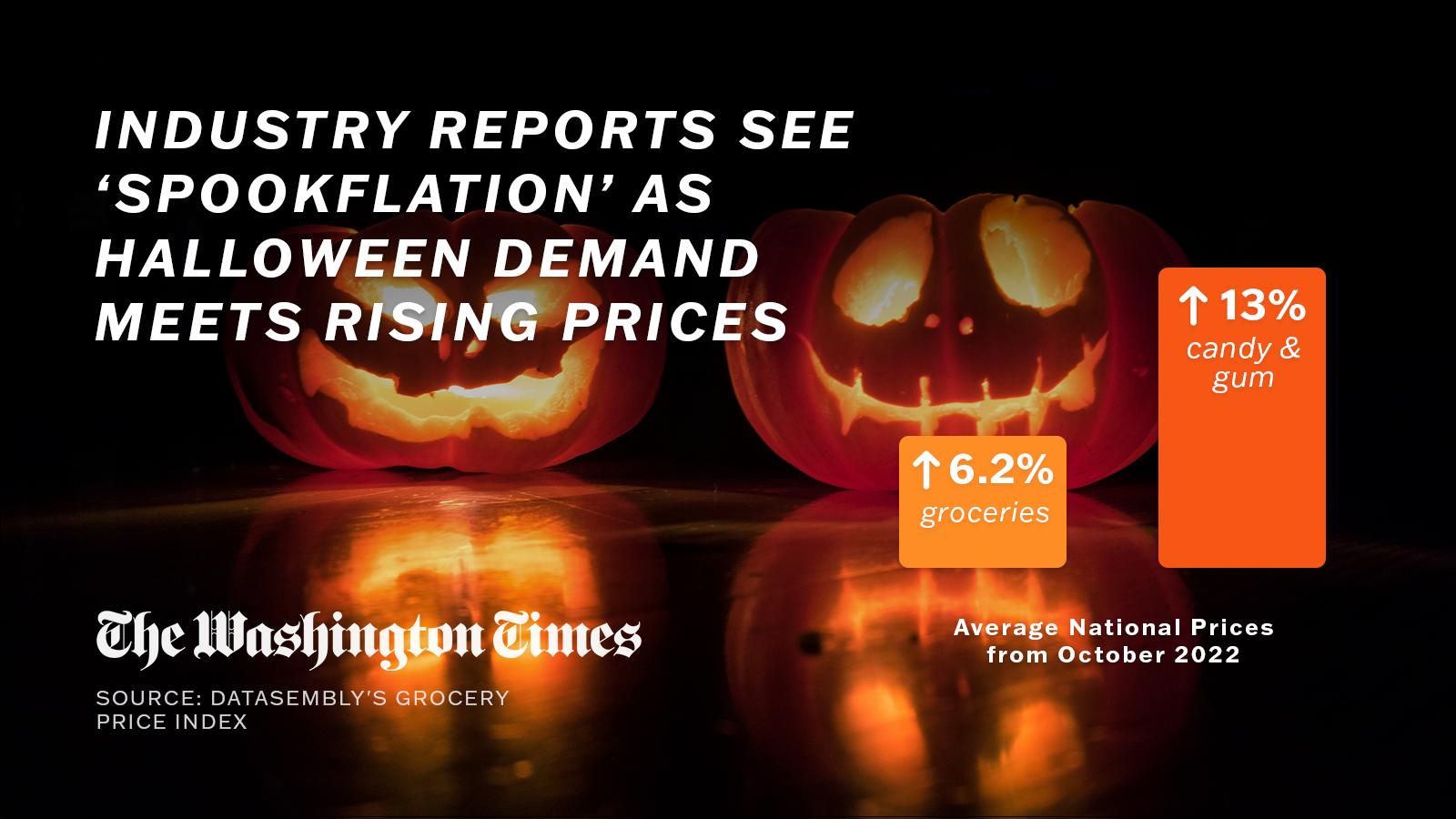Holiday ghosts and ghouls will feel the bite of rising prices for candy and chocolate this Halloween, recent industry reports suggest.
The average national price for candy and gum is up by 13% this month from October 2022, according to Datasembly’s Grocery Price Index, which tracks weekly changes at more than 150,000 stores nationwide. By comparison, overall grocery prices have risen by 6.2%.
“Despite this spike, the shelf level changes we’re seeing across out-of-stock rates suggest that consumer demand continues,” Brad LaRock, a vice president at the retail data collection firm, told The Washington Times.

Several retail analysts told The Times that two years of rising prices for sugar cane, cocoa, nuts and packaging have combined with increased interest in Halloween to squeeze wallets more tightly this year.
“Thanks to inflation, Halloween is becoming a trick for Americans with wallets,” said Michael Austin, a former economic adviser to two Kansas governors and a scholar at the conservative American Enterprise Institute.
“Government overspending is the real boogeyman, not global dynamics, and the solution requires central banks and the government to trim their budgets, excess currency, and balance sheets to fend off inflation becoming the biggest scare of 2023,” Mr. Austin said.
Food prices rose 3.7% year-over-year in September, the same as general inflation, according to the Bureau of Labor Statistics.
By comparison, U.S. sugar prices are up by 10% from last year, according to an analysis by the St. Louis Federal Reserve.
Sugar already costs twice as much in the U.S. as in the rest of the world due to import tariffs, government subsidies and a quota restricting supply, said Ryan Young, an analyst at the libertarian Competitive Enterprise Institute.
“Weather and wars are also to blame,” Mr. Young said. “Bad weather hurt sugar crops in India, Thailand, China, and Europe. Russia’s Ukraine invasion hurt beet production there and blocked exports.”
According to market researcher Pattern, the prices of candy and chocolate staples for trick-or-treating have risen more steeply than general inflation since last October.
The top 10 increases are Airheads (up 26% from last year), Baby Ruth (up 14%), Candy Corn (13%), PayDay (12%), Tootsie Rolls (11%), Jolly Ranchers (also 11%), Junior Mints (10%), Starburst (10%), Dots (9%) and Smarties (8%).
Meanwhile, the company said costume prices have fallen by 6%-12% and decoration prices by 6%-11%.
“Depending on the part of the world where these goods are made, everything from the cost of raw materials to shipping and labor could be impacting prices this Halloween,” said Hamilton Noel, Pattern’s data scientist.
In a survey released Oct. 17 by the Harris Poll and the Halloween & Costume Association, 66% of adults who celebrate Halloween said price increases have affected their plans this year. As a result, 36% planned to spend less and 42% identified pricing as the main influence on their costume choice.
“The survey results indicate that the impact of inflation and budget constraints on the Halloween-loving masses could potentially affect industry sales for 2023,” the Halloween industry group noted.
As of this week, Halloween candy sales are down from last year and costume sales are up, said Peter C. Earle, an economist at the free market American Institute for Economic Research in Massachusetts,
“If I were to guess, this year’s jump in costume spending reveals a continuing post-COVID return to in-person … costume parties, wearing Halloween regalia in the office, and so on,” Mr. Earle said.
He noted that raw sugar and cocoa prices have risen steeply every year since the pandemic after falling annually from 2013 to 2020.
“When input prices jump that much, consumer prices will inevitably leap with them,” Mr. Earle said.
Rising costs throughout the supply chain have also hurt some annual Halloween celebrations struggling with fixed or diminished budgets.
In Washington, the DC Strings Workshop relocated its annual “Halloween Spooktacular” concert after one venue raised its rental price from $500 last year to $1,500 this year. The venue cited increased energy and insurance costs.
At the same time, the price of 30 boxed lunches containing sandwiches, cookies and potato salad for the musicians increased from $250 to more than $400. As a result of rising prices, the group said it could no longer afford to livestream concerts.
“In comparison to last year, we’ve seen a noticeable increase in costs for venue rental, decorations, A/V equipment, catering, and even basic supplies,” said Andrew M. Lee, artistic and executive director of DC Strings Workshop. “The rising prices have made it challenging to maintain the same quality while adhering to a tighter budget.”
As Americans get used to paying more for less, inflation is driving an overall spike in Halloween spending.
The National Confectioners Association estimates that candy and chocolate sales will grow annually from $42.6 billion in 2022 to $54.3 billion by 2027.
That growth has been “driven in part by inflation” and an “incredibly resilient” demand for sweets even in tough economic times, said Carly Schildhaus, a spokesperson for the trade group.
“The industry is committed to ensuring that chocolate and candy remain an affordable treat for consumers,” Ms. Schildhaus said, noting there is no shortage of treats for Halloween this year.
The National Retail Federation projects Americans will spend a record $12.2 billion on Halloween, topping the previous record high of $10.6 billion last year, thanks primarily to growth in costume sales.
The industry group predicts the average consumer will spend $108.24 on Halloween candy, decor, cards and costumes. Its survey found 73% of adults plan to celebrate the holiday, up from 69% last year.
The NRF figures confirm that “relatively low unemployment” and a willingness to keep spending on holidays as prices rise are “tempering the effects of inflation,” said Tom Arnold, a finance professor at the University of Richmond.
“Based on the data, it appears the consumer intends to enjoy Halloween despite paying higher prices,” Mr. Arnold said.
• Sean Salai can be reached at ssalai@washingtontimes.com.



Please read our comment policy before commenting.